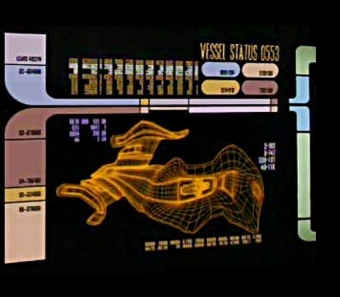
In Star Trek, a spatial implosion is a type of spatial
anomaly where space-time is compressed, crushing any objects occupying
it. A distortion ring that enveloped the USS Voyager in 2371 also
seemed to act as a spatial implosion, that eventually would crush the
ship. It later emerged that this was not the case, as the ring was in
fact a lifeform that released Voyager unharmed. (VOY: "Twisted").
In real physics, the term implosion is a process in
which objects are destroyed by collapsing on themselves. The opposite
of explosion, implosion concentrates matter and energy. Implosion is a
key part of the gravitational collapse of large stars, which can lead
to the creation of supernovae, neutron stars and black holes.
Gravitational collapse in astronomy is the inward fall
of a massive body under the influence of the force of gravity. It
occurs when all other forces fail to supply a sufficiently high
pressure to counterbalance gravity and keep the massive body in
hydrostatic equilibrium.
Gravitational collapse is at the heart of structure
formation in the universe. An initial smooth distribution of matter
will eventually collapse and cause the hierarchy of structures, such as
clusters of galaxies, stellar groups, stars and planets. For example, a
star is born through the gradual gravitational collapse of a cloud of
interstellar matter. The compression caused by the collapse raises the
temperature until nuclear fuel ignites in the center of the star and
the collapse comes to a halt. The thermal pressure gradient (leading to
expansion) compensates the gravity (leading to compression) and a star
is in dynamical equilibrium between these two forces.
Gravitational collapse of a star occurs at the end of
its life time, also called the death of the star. When all stellar
energy sources are exhausted, the star will undergo a gravitational
collapse. In this sense a star is in a "temporary" equilibrium state
between a gravitational collapse at stellar birth and a further
gravitational collapse at stellar death. The end states are called
compact stars.
Even more massive stars, above the
Tolman-Oppenheimer-Volkoff limit cannot find a new dynamical
equilibrium with any known force opposing gravity. Hence, the collapse
continues with nothing to stop it. Once it collapses to within its
Schwarzschild Radius, not even light can escape from the star, and
hence it becomes a black hole. At some point later the collapsing
object must reach the planck density (as there is nothing that can stop
it), where the known laws of gravity cease to be valid. There are
competing theories as to what occurs at this point, but it can no
longer really be considered gravitational collapse at that stage.
|
